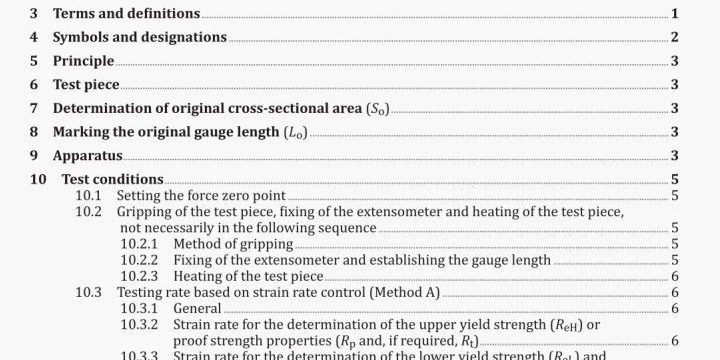Method of test at elevated temperature
AS 2291-2020 pdf download.Metallic materials-Tensile testing – Method of test at elevated temperature.
10.1 Setting the force zero point
The force-measuring system shall be set to zero after the testing equipment has been assembled but before the test piece is actually placed in the gripping jaws. Once the force zero point has been set, the force-measuring system may not be changed in any way during the test.
NOTE The use of this method ensures that the weight of the gripping system is compensated in the force measurenwnt and that any force resulting from the clamping operation does not affect the force zero point.
10.2 Gripping of the test piece, fixing of the extensometer and heating of the test piece, not necessarily In the following sequence
10.2.1 Method of gripping
For requirements concerning the nwthod of gripping, see Iso 6892-1.
NOTE Maintaining a very small tensile load (e.g. test machine in load control) during heating period and soaking time can prevent possible compressive stresses due to thermal expansion.
10.2.2 Fixing of the extensometer and establishing the gauge length
10.2.2.1 General
Different methods of establishing the extensometer gauge length are used in practice. This can lead to minor differences in the test results. The method used shall be documented in the test report.
10.2.2.2 L based on room temperature (Method 1)
The extensometer is set on the test piece at room temperature with nominal gauge length. The extension is measured at test temperature and the percentage extension is calculated with the gauge length at room temperature.
The thermal extension is not considered.
10.2.2.3 Le based on test temperature (Method 2)
This Le includes the thermal extension of the test piece.
10.2.2.3.1 Nominal Le at test temperature (Method 2 a)
The extensometer is set on the test piece at the test temperature with nominal gauge length before mechanical loading.
10.2.3 HeatIng of the test piece
The test piece shall be heated to the specified temperature, T, and shall be maintained at that temperature for at least 10 mm before loading (soaking time). The loading shall only be started after the output of the extensometer has stabilized.
Quite often, longer times can be required to bring the entire cross-section of the material up to the specified temperature.
During heating, the temperature of the test piece shall not exceed the specified temperature with its tolerances, except by special agreement between the parties concerned.
10.3 Testing rate based on strain rate control (Method A)
10.3.1 General
This method is intended to minimize the variation of the test rates during the moment when strain rate- sensitive parameters are determined and to minimize the measurement uncertainty of the test results.
For additional requirements concerning testing rate based on strain rate control (Method A), see
ISO 6892-1.
It is not always the case that all properties of the tensile test at room temperature will be determined at elevated temperature. Hence, only the appropriate test rates/modes for the properties to be determined shall be used (see Figurei).
10.3.2 Strain rate for the determination of the upper yield strength (ReH) or proof strength properties (R and, If required, R)
For additional requirements concerning strain rate for the determination of the upper yield strength (ReH) or proof strength properties (R and, if required, Ri), see ISO 6892-1, but observe the following specified range:
— Range 1: CL = 0,000 07 s-i (equal to 0.0042 mln1), with a relative tolerance of ±20% (recommended unless otherwise specified);
— Range 2: = 0,000 25 s1 (equal to 0,0 15 rniwl), with a relative tolerance of ±20 %. See also 1igurel.
10.3.3 Strain rate for the determination of the lower yield strength (RL) and percentage yield point extension (Ae)p if required.AS 2291-2020 pdf download.
Method of test at elevated temperature
